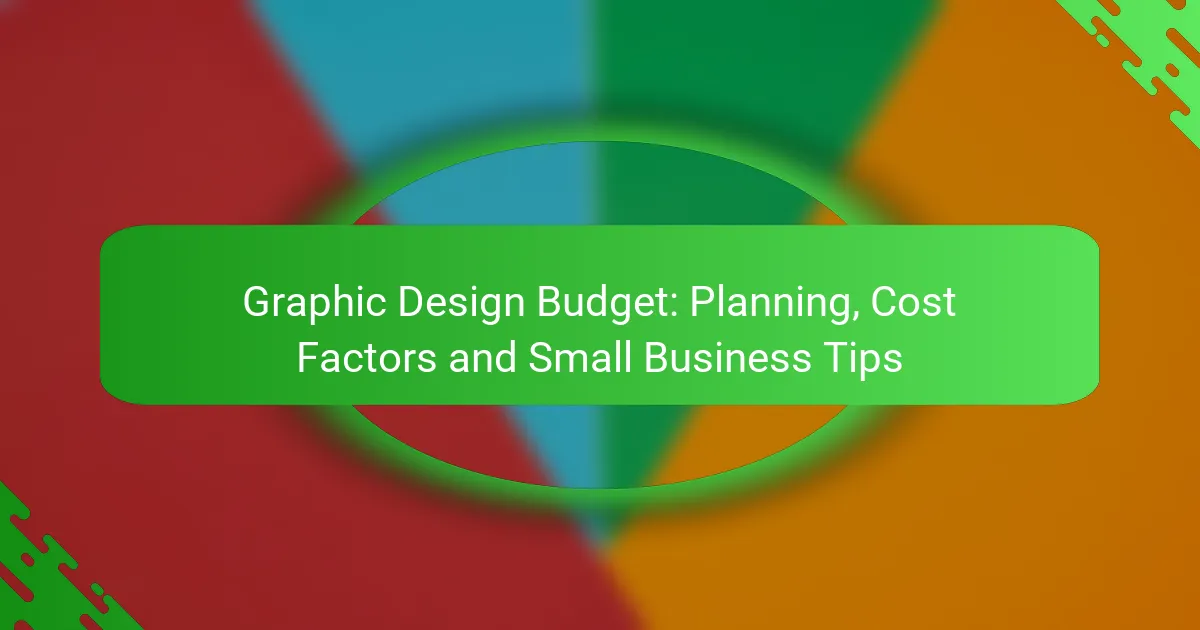Creating a graphic design budget is essential for small businesses to effectively manage resources and align design projects with their overall goals. By assessing project needs and understanding key cost factors such as designer experience and project complexity, businesses can make informed decisions. Choosing the right design services tailored to specific requirements and budget can further enhance the effectiveness of their graphic design efforts.

How to create a graphic design budget for small businesses?
Creating a graphic design budget for small businesses involves assessing project needs, estimating costs, and planning for potential adjustments. A well-structured budget helps manage resources effectively and ensures that design projects align with business goals.
Identify project scope and goals
Defining the project scope and goals is crucial for establishing a graphic design budget. This includes determining the type of design work needed, such as branding, marketing materials, or digital content. Clearly outlining objectives helps in estimating the time and resources required.
Consider factors like target audience, desired outcomes, and any specific design elements that must be included. This clarity will guide the budgeting process and prevent scope creep, which can lead to unexpected costs.
Estimate design hours and rates
Estimating design hours and rates is essential for calculating the labor costs in your budget. Research typical hourly rates for graphic designers in your area, which can range from $25 to $150 per hour depending on experience and expertise. For small businesses, hiring freelancers or agencies may offer flexibility and cost savings.
Next, assess how many hours the project will likely take. Break down tasks into smaller components, such as brainstorming, drafting, and finalizing designs. This detailed approach allows for a more accurate estimate of total hours needed.
Include software and tool costs
Incorporating software and tool costs into your graphic design budget is vital. Many designers use industry-standard software like Adobe Creative Cloud, which typically requires a subscription fee. Budget for these recurring costs, which can range from $20 to $80 per month per user.
Additionally, consider any other tools or resources that may be necessary, such as stock images, fonts, or printing services. These expenses can add up, so it’s important to account for them in your overall budget.
Factor in revisions and feedback cycles
Revisions and feedback cycles are an integral part of the design process that can impact the budget. Allow for multiple rounds of feedback to refine the design, as this can lead to additional hours of work. Establish a clear process for collecting feedback to streamline revisions and minimize delays.
Set a limit on the number of revisions included in the initial budget to avoid excessive costs. For example, consider including two rounds of revisions in your estimate, with additional revisions billed at an hourly rate. This approach helps manage expectations and keeps the project on track financially.

What are the key cost factors in graphic design?
The key cost factors in graphic design include the designer’s experience, the complexity of the design projects, and the geographic location of the services. Understanding these factors can help businesses budget effectively for their graphic design needs.
Designer experience and expertise
The experience and expertise of a designer significantly influence the cost of graphic design services. More seasoned designers typically charge higher rates due to their refined skills and proven track record. For instance, junior designers might charge between $25 to $50 per hour, while experienced professionals can command rates from $75 to $150 per hour or more.
When selecting a designer, consider their portfolio and client testimonials to gauge their expertise. Investing in a skilled designer can lead to better results, potentially saving costs in revisions and project delays.
Complexity of design projects
The complexity of a design project directly impacts its cost. Simple projects, such as logo design or basic flyers, usually require less time and expertise, resulting in lower costs. In contrast, intricate projects like branding packages or multi-page websites demand more resources and can range from hundreds to thousands of dollars.
To manage costs effectively, clearly define project scopes and expectations upfront. This clarity helps avoid scope creep, which can lead to unexpected expenses and extended timelines.
Geographic location of services
The geographic location of graphic design services can affect pricing due to varying market rates. For example, designers in major cities like New York or London may charge significantly more than those in smaller towns or rural areas. This difference can be attributed to higher living costs and demand for services in urban settings.
When hiring a designer, consider both local and remote options. Remote designers can offer competitive rates, but ensure they understand your market and can deliver designs that resonate with your target audience.

How to choose the right graphic design services?
Choosing the right graphic design services involves assessing your specific needs, budget, and the expertise of designers. Consider factors like the scope of your project, the level of creativity required, and whether you prefer working with freelancers or agencies.
Compare freelance vs agency rates
Freelancers typically charge lower rates than agencies, making them a cost-effective option for small projects. Freelance graphic designers may charge anywhere from $25 to $150 per hour, while agencies often charge $100 to $300 per hour, reflecting their overhead costs and team expertise.
When comparing rates, consider the value each option brings. Freelancers may offer personalized service and flexibility, while agencies provide a broader range of services and a collaborative team approach. Evaluate your project needs to determine which option aligns best with your budget and expectations.
Evaluate portfolios and past work
Reviewing portfolios is crucial to understanding a designer’s style and capabilities. Look for diversity in their work, including different industries and design types, to ensure they can meet your specific requirements.
Pay attention to the quality of their designs, the creativity displayed, and how well their previous work aligns with your vision. A strong portfolio should demonstrate not only aesthetic appeal but also effective communication of brand messages.
Check client testimonials and reviews
Client testimonials and reviews provide insight into a designer’s reliability and professionalism. Look for feedback on their communication, adherence to deadlines, and overall satisfaction with the final product.
Websites like Clutch or Upwork can be useful for finding verified reviews. Aim to read multiple testimonials to get a balanced view, and consider reaching out to past clients for direct feedback on their experiences.

What are effective tips for managing design costs?
Managing design costs effectively involves strategic planning and clear communication. By setting expectations, utilizing templates, and negotiating pricing, small businesses can optimize their design budgets.
Set clear expectations and timelines
Establishing clear expectations and timelines is crucial for managing design costs. Define the project scope, deliverables, and deadlines upfront to avoid misunderstandings that can lead to additional expenses.
Consider creating a project brief that outlines objectives, key milestones, and deadlines. This document serves as a reference point for both you and the designer, helping to keep the project on track and within budget.
Use design templates for efficiency
Utilizing design templates can significantly reduce costs and time spent on projects. Templates provide a structured foundation that can be customized, allowing for quicker turnaround without sacrificing quality.
Many platforms offer free or low-cost templates for various design needs, such as social media graphics, brochures, and presentations. By leveraging these resources, small businesses can maintain a professional appearance while keeping expenses low.
Negotiate fixed pricing agreements
Negotiating fixed pricing agreements with designers can help manage costs effectively. Fixed pricing allows you to know the total cost upfront, reducing the risk of unexpected expenses as the project progresses.
When discussing pricing, consider the scope of work and the designer’s experience. A well-defined contract that outlines deliverables, timelines, and payment terms can protect both parties and ensure clarity throughout the project.

How to track and adjust your graphic design budget?
To effectively track and adjust your graphic design budget, regularly monitor your spending and compare it against your initial estimates. This proactive approach helps identify discrepancies early, allowing for timely adjustments to keep your project on track.
Use budgeting software like QuickBooks
Utilizing budgeting software such as QuickBooks can streamline your financial tracking. These tools allow you to categorize expenses, set budget limits, and generate reports that provide insights into your spending patterns. By automating these processes, you can save time and reduce the risk of human error.
Consider integrating your design project management tools with your budgeting software for a more cohesive overview. This integration helps ensure that all financial data is up-to-date and reflects any changes in project scope or costs.
Monitor expenses against initial estimates
Regularly comparing your actual expenses to your initial budget estimates is crucial for effective financial management. Set specific intervals, such as weekly or monthly, to review your spending and identify any areas where costs are exceeding expectations.
Use visual aids like charts or graphs to track these comparisons easily. This practice not only highlights overspending but also helps you understand where adjustments may be necessary, ensuring that you stay within your overall budget.
Adjust budget based on project changes
As projects evolve, so too should your budget. Be prepared to adjust your financial plan in response to changes in project scope, timelines, or unexpected expenses. This flexibility is essential for maintaining financial control and ensuring project success.
Establish a protocol for budget adjustments, such as requiring approval for any significant changes. This can help maintain accountability and ensure that all team members are aligned with the updated financial expectations.



